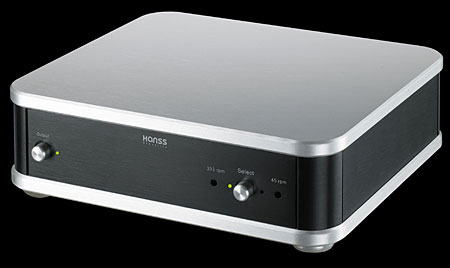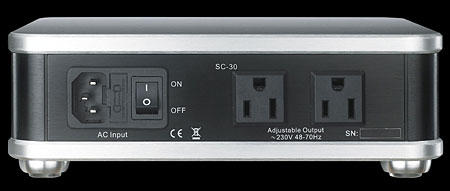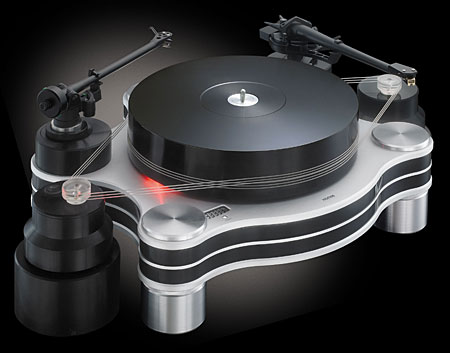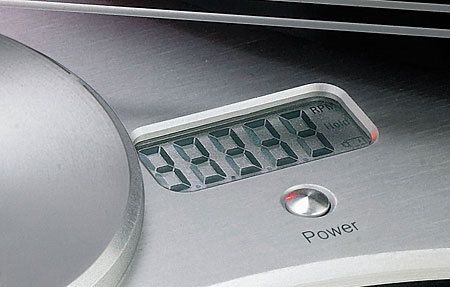| Columns Retired Columns & Blogs |
Hanss Acoustics T-30 turntable Page 2
So I was doubly surprised that the Hanss T-30, which I used during the latter half of summer 2009, was supremely immune to footfalls. Normal foot travel never—and I mean never—displaced the stylus, or created even an untoward noise. Jumping up and down on the floor next to the rack made itself known as only a small and temporary variation in speed: a bit of warble, for want of a better word. The only way I could get the needle away from the groove was to lift the tonearm. Read into that what you will. I was impressed.
Footnote 2: Except, of course, for the Voyd/Audio Note turntables that combine belt drive with three high-torque motors!
Happily, the Hanss T-30 played music well, too, with a consistently big sound: good scale and exceptional bass weight. Better still, it performed acceptably well at something I consider crucial to musical involvement: With the Hanss T-30, recorded music had at least some sense of momentum, of pull. There are record players that deliver even more of that quality—mostly ones with decidedly high-torque motors, I've found—but the Hanss T-30 was better than a lot of the contemporary belt-drive models I've heard (footnote 2). And really—without at least some sense of momentum and flow, you might as well listen to CDs.


Large-scale classical music fared best with the Hanss. The opening of Beethoven's Symphony 4, performed by Pierre Monteux and the London Symphony Orchestra (LP, Victrola/Classic VICS 1102), had the right amount of tension, with richly good colors and textures in all instrumental sections. Only during the early bars of the third movement did the Hanss's bass and low-midrange weight seem to confound the notes themselves: The rhythm there was slightly less apparent—temporally less clear—than it was with my Thorens TD-124 Mk.II.
Dynamically, the Hanss was at least the equal of my reference. That and the T-30's weighty presentation made piano music a delight, in stereo and mono alike. (With regard to the latter, try any of Gieseking's Beethoven recordings on Angel to hear what I mean.) Certain pop LPs sounded equally dramatic, especially good live recordings, such as Neil Young's Time Fades Away (LP, Reprise MS 2151) and Fairport Convention's House Full: Live at the LA Troubadour (LP, Hannibal HNBL 1319). The instrumental break following Dave Swarbrick's drily sung "Grant me one small relief," in House Full's "Banks of the Sweet Primroses," was appropriately louder and more forceful than the preceding line: a nice touch missed by so many source components.

But listening to other pop LPs, even more than with the above-mentioned Beethoven recording, I missed my Thorens's greater clarity of timing. "Minor Swing," from David Grisman's Hot Dawg (LP, Horizon SP 731), sounded present and good, but it was less nuanced than I'm used to hearing: The Hanss, in a word, didn't swing. There was also just a bit too much thickness and sustain in the sound of Eddie Gomez's string bass; on the Thorens, it was just as deep but a lot faster.
On the plus side, instrumental images had excellent body and presence with the Hanss: On the Grisman LP, Stéphane Grappelli's fiddle was there, front and center. And all the instruments on Fairport's House Full were delightfully more substantial than usual. Dave Mattacks' wonderful ride-cymbal work was especially enjoyable on "Sir Patrick Spens," and both guitars had fine physical attack—especially the one played by Fairport stalwart Simon Nicol, who, I believe, was firmly in the heavy-string camp back then.
A final and perhaps inconsequential note: During use, one or more of the T-30's six belts could often be seen skittering up and down the massive platter's rim, howsoever slightly, apparently coaxed into vertical motion by the minute grooves left behind by the machining process. I listened closely, to try to detect any audible consequence of this—flutter, lack of pitch stability, whatever—and heard none.
Conclusions
Most American men will never spend $100 on a bottle of Cognac or $1000 on a suit. That doesn't mean that Maison Surrenne single-vintage XO or an undarted J. Press "Pressidential" aren't bargains: They are, clearly and honestly.

Assuming that perfectionist audio is your luxury of choice, here's something else for the list: the Hanss T-30, which offers the buyer two tonearm mounts, two motors, a massive platter, magnetic isolation, exotic styling, and an inarguably fine level of manufacturing quality, all for $4600. Yes, that's wildly more money than most people would consider spending on a record player; and, yes, that's good value.
There's a lot of very good competition at or near this price: Upmarket models from Linn, Roksan, Well Tempered, VPI, Clearaudio, and Rega can be had for under $5000, all with different presentations and system compatibilities. For the adventurous, the same amount could buy a classic Thorens or Garrard in excellent original or restored condition. Still, the user-friendly Hanss T-30 is a distinctive choice with a combination of sonic and musical qualities that may well suit your system—and your music: Not quite a shoo-in, but very much worth a close look and listen.
Footnote 2: Except, of course, for the Voyd/Audio Note turntables that combine belt drive with three high-torque motors!
- Log in or register to post comments




































